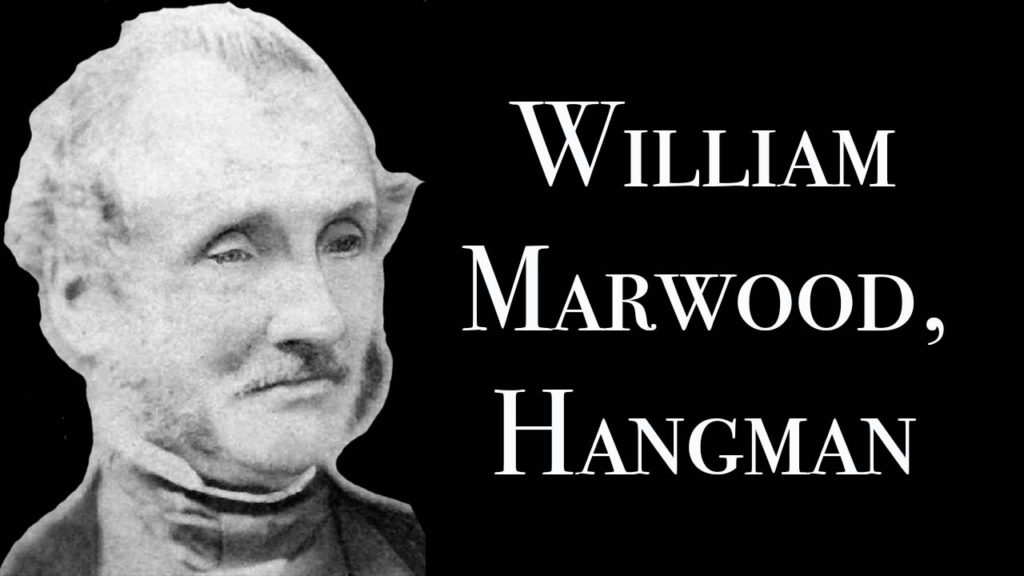
Like hangman Calcraft, Marwood’s first trade was shoemaker, but in 1872, when he was 54 years old, he asked the governor of Lincoln Castle Gaol to allow him to conduct an execution. He was granted permission and on April 1 he performed his first execution without any problems.
Two years later, he took over Calcraft’s position as appointed hangman.
Those who have watched my video on Calcraft know that Calcraft used the short drop method that caused a slow death by strangulation. Marwood was different. He used a long drop that would instantly break the prisoner’s neck. This was considered a far more humane death than allowing a prisoner to struggle at the end of a rope for several minutes.

Marwood took on the role of hangman for eleven years, and it is estimated that he swung 179 people.
It was said that he would, when appropriate, use soothing words to ease men’s anxieties before a hanging. “Come on now,” he would say, “I won’t hurt you and it will all be over in a minute. It will be all right. Just leave it to me.” [Source]
However, not all of his hangings went well. One scathing report came out in August of 1879:
“England has been shocked by a bungling execution, and it appears to be settled that Marwood, the hangman, is an ignoramus, who is permitted to try experiments on the condemned. At Newgate, one James Dilley [who was convicted for murdering his 3 week old illegitimate daughter] was to be put to death. Marwood arranged for a fall of six feet. The man, after experiencing the horror of such a fall, finally died only of strangulation. Scientific persons are of the opinion that the wretch must have been torturously racked and have died in great agony. The long fall is a failure. The old gallows, it is thought, killed much more mercifully than the new-fangled machines which have been introduced.” [Source]

Shortly after Marwood had hanged a prisoner named Wood in 1881, a reporter from the Sheffield Daily Telegraph had the opportunity to speak to him. The interview began with Marwood speaking:
“’It was a grand execution! Wood never moved even a finger,’ were the first words uttered when he entered the room where a number of persons were assembled; ‘I gave him the long drop, nine feet four inches, and he died as peacefully as a lamb.’
“‘What is your reason for having such a long drop?’ someone asked.
“Lifting up his hands and raising his eyes, he exclaimed, in dramatic tones, ‘It is humane and saves suffering; the man dies instantly.’
“He had not seen Wood before he met him in the cell a few minutes before the execution, but when he did see him he was very unfavorably impressed with his face. He thought him a cold-hearted, callous man, and was confident of his guilt. In reply to a question respecting the rope, he called for his bag. His visitors held their breath while he slowly unfastened the leathern straps which were round it, applied the key to the lock, opened the bag, and brought out its contents, which proved to be two ropes and a few pinioning straps. One rope, a thick one, measuring about three inches in circumference, was the rope which he had used around the neck the preceding morning of the Aylesbury murderer, and with which he had also executed Wood. The other was a smaller rope, perhaps an inch in circumference. It was a curious sight to behold Marwood contemplating the ropes. He gazed upon them smilingly, fondly handling them as tenderly as a mother would handle a baby, a connoisseur a piece of rare china, a young lady a bonnet of the latest fashion.
“’This rope,’ said he, holding up the thickest, ‘is the rope; it is made of the finest Italian hemp; it is the rope of the good old times.’ Here he grew rather eloquent and earnest, and with emphasis added, ‘This rope is made specially for me, and is supplied by the government. Look how beautiful and smooth it is; feel it, it is a real beauty.’
“The visitors felt it, but failed to see much beauty.
“’Don’t be frightened of it, there are no blood stains on it.’ He said this because it was being very closely and critically examined. ‘I never shed blood, and never yet broke the skin of any of my patients.’ [Source]

That was not the first, or the last time, Marwood had acted rather strangely. Another reporter told the following story after Marwood had passed away:
“I have Marwood’s own word for it that at the last moment, after the cap is pulled over the face, under pretense of arranging the noose more carefully, he presses with his thumb quickly and with great force just below the Adam’s apple with the intent, as he claims, of depriving the condemned of consciousness. Whether this is a desirable feature or not, I leave to hangmen.
“Marwood was a voluptuary in his calling, and in moments of inebriety found greatest pleasure in toying with the neck and throats of his companions. On one occasion when an actor, well known and highly esteemed in this city, was on a grand tour through the English provinces, on going to his dressing room he found a party of convivialists, who had called to pay him their respects. There was the sheriff, other officials, and Marwood, the hangman. Clad in the classic garb of Hamlet, the actor was a picture of manly beauty, and Marwood, who had been drinking freely, placing his hands upon the actor’s bust, said, ‘What a superb neck you have. How I would like to put a rope about your throat.’ Conversation turned upon the pleasant performance of this cheery companion, and he gave a practical illustration of his throat pushing custom, very much to the annoyance of the actor.
“In the party was an American. Upon him Marwood attempted to experiment, but becoming somewhat rough in his treatment the American, who could stand it no longer and who was intensely disgusted by the entire procedure, drew off and with appropriate exclamation, struck the little nuisance squarely in the jaw, knocking Marwood with great force against a full length mirror, which was shattered into fragments.” [Source]
Marwood was hated by the Irish, as so many Irishmen had been hanged by him.
In 1882, it was reported that, “Marwood the hangman arrived in Ireland last evening to superintend the execution of Francis Hynes. Marwood is guarded by police and a number of Irish detectives will escort him to Limerick.” [Source]
It was during this time that Marwood was threatened with assassination if he dared to go to Ireland to perform the hangings.
It was reported that: “Besides keeping a standing army of soldiers and constables in Ireland, England is doing her level best to keep Marwood, the hangman, busy in that unhappy land. It would not be quite so one-sided if they would turn in and hang an Englishman occasionally.” [Source]

On May 14th, 1883, Marwood hung Joe Brady, a member of the radical Fenians called the Invincibles. A report out of Dublin read:
“Joe Brady was hanged at 8 o’clock this morning. A [large group] of people gathered around the prison yard in which Brady was executed this morning. A strong force of cavalry, infantry and police were present to preserve order. There was no attempt at disturbance, however, the crown conducting itself with creditable decorum.
“His body fell nine feet, and his death was instantaneous.
“It is estimated that 10,000 persons were outside the jail.
“At the moment the black flag was seen over the jail a cry was raised of ‘hats off,’ and every head was uncovered. The crowd shortly afterwards dispersed.” [Source]
Marwood died later that year on September 4,1883. Rumor was that the Invincibles had poisoned him, but the official version is that he died of pneumonia.
His personal belongings were offered up in a public sale. It was reported that:
“Hundreds of relic hunters from all parts of England attended, and at times bidding was very spirited. There was some disappointment expressed that among the articles for sale there were not more ropes, the taste of the crowd appearing to run in that direction. It seems, however, that the dead executioner had disposed of the majority of the ropes which had done service on noted criminals to his favorite friends. An old ragged valise in which Marwood used to carry his ropes to and from executions, sold for $6. A pair of old stockings, said to be the last pair Marwood wore, and which were taken from his body at death, brought $2. A gentleman in the crowd to whom Marwood had willed two favorite ropes allowed the auctioneer to put them up for sale, and they caused active bids, being finally knocked down for $220. The sale was very exciting, but soon over.” [Source]
Like Calcraft, there are numerous stories about Marwood reported in the newspaper archives. He was an odd, though fascinating character in a long line of hangmen that have graced, or disgraced, history.

